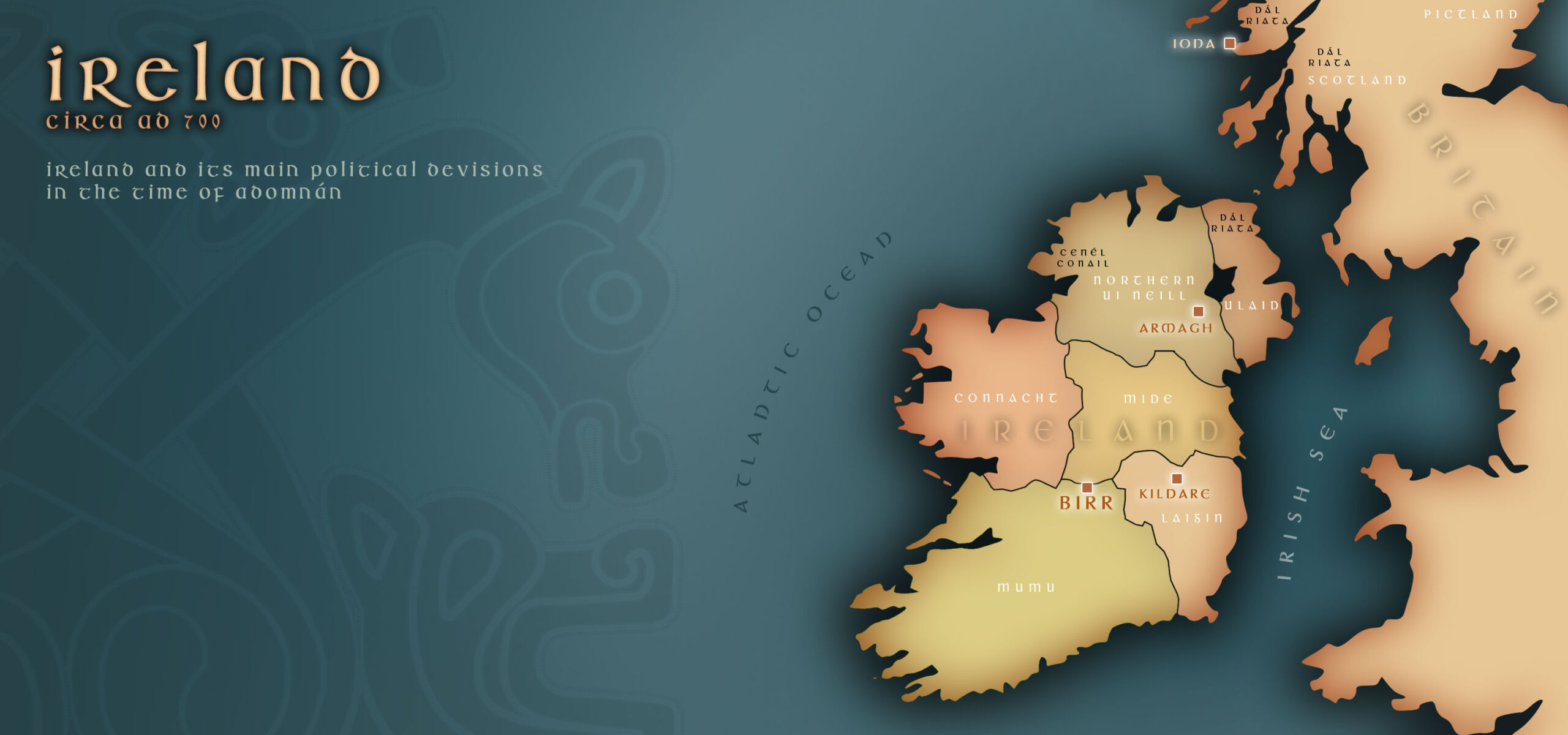

This does not attempt to be a detailed history. It is a brief account of the history that has inspired the creation of Lex Innocentium, 21st Century. Most of the account of Adomnán and his Lex Innocentium is taken from the work of James W. Houlihan listed below. Anything appearing in quotation marks in relation to Adomnán and his law is a direct quotation from Dr. Houlihan’s work. We have also included some other important sources and recommended reading.


A BRIEF ACCOUNT OF AN INSPIRING HISTORY
Lex Innocentium, 21st Century takes its name from the original Lex Innocentium, Cáin Adomnáin or Adomnán’s Law, which was signed and promulgated at the Synod of Birr (Co. Offaly) in the summer of the year 697 AD. In his Lex Innocentium, Adomnán secured protection in times of war for women, children, clerics, penitents and those in the care of the church. While this might not have been the first law in relation to the conduct of war, it was probably the first law to identify specific non-combatants (‘innocents’) and to procure protection for them.
Adomnán was an Irish Monk, born in or around the year 627/28 AD, probably in Co. Donegal. His parents, Rónán and Rónnat, were of two separate branches of the Cenél Conaill, whose homeland was in the region now known as Co. Donegal. Adomnán was a fourth cousin of Loingseach mac Óengusso, who became King of Tara in the year 695 AD and who was one of the signatories of Lex Innocentium. Adomnán was also related through Cenél Conaill to Columba (Colmcille), founder of the Abbey at Iona. In fact, Adomnán was writing his life of Columba, Vita Columbae, at the time of the Synod of Birr in 697, the centenary year of Columba’s death. According to the annals of Iona, Adomnán died in 704, in his seventy-seventh year. His death and feast day are commemorated and celebrated on the 23rd of September every year.
Adomnán became the Ninth Abbot of Iona in the year 679 AD. At that time, Iona was an important centre of the Irish Church. The Abbot of Iona presided over ‘a confederation’ of monasteries across Ireland and Western Scotland. Adomnán was a man of immense learning, talent and ability. Ireland of the seventh century was known for its religion and its learning. People from Britain and Europe ‘looked to Ireland for instruction in religion as well as other subjects, such as Latin, rhetoric, grammar, geometry, physics and computus’ (calculation of the date of Easter). However, Ireland could also be a violent place, with conflicts, disputes, and battles underway in various places at various times. Adomnán, no doubt, would have been aware of and witnessed violence in his lifetime. Indeed, it is suggested that it was his experience, with his mother, Rónnat, of witnessing the horrendous aftermath of a battle in Brega (Co. Meath) that deepened his abhorrence of violence against unarmed people whom he called ‘innocents’.
According to this story, Adomnán and Rónnat came upon the bodies of a mother and child, with both mother’s milk and blood streaming from the baby’s mouth. Looking upon this tragic scene, Rónnat told Adomnán that he must do something to protect the women of Ireland. While this specific account might not be true or wholly accurate, it may well be that Adomnán was moved by such an incident. His very real concern for the welfare of innocent people in times of war resulted in the calling of the Synod of Birr and the enactment of Lex Innocentium (the Law of the Innocents).
Adomnán’s law did not prohibit war or violence. Indeed, some of its signatories went on to fight in battle after the promulgation of the law. Nevertheless, while Adomnán’s law was a law of its time, its very adamant protection of the innocents it identified was significant and inspirational for its time and for ours too.
Adomnán’s connections with noble families in Ireland, his position as Abbot of Iona and his reputation as a wise and learned man empowered him to invite kings and other civil leaders, as well as bishops and abbots of the church, to his Synod at Birr. In all, there were ninety-one signatories to Lex Innocentium, forty clerical leaders and fifty-one lay persons. They came from all over Ireland, Dál Riata (parts of Western Scotland-and-the-Isles and of Northern Ireland) and Pictland (Scotland). It is not certain that all of the signatories were present at the Synod, but there is a strong likelihood that they were. The law was to be enacted in Ireland and in Britain.
It is unclear as to the exact application or impact of this law in Ireland and Britain. However, there are some mentions of it in the records down through the years. Most interestingly, almost a thousand years after the Synod of Birr, in the winter of the year 1628/29, Franciscan Brother, Micheál O’Cléirigh, leader of the Four Masters, discussed his copy of the Law of Adomnán with Flann Mac Aodhagáin (Mac Egan) of the lawyer family at Redwood Castle at Lorrha, Co. Tipperary.
The old Irish Order (including Brehon Law) was on the point of collapse as the British extended their control over Ireland, and particularly following the Flight of the Earls in September 1607. O’Cléirigh had been sent by his superiors in Louvain to compile a record of Irish Saints. However, thankfully for us now, he extended his brief to include ancient Irish history and Irish law, before they were lost to memory. Over a number of years, he travelled the length and breadth of Ireland collecting histories and copying manuscripts. Within twenty years of the meeting at Redwood, the castle was abandoned and in ruin.
O’Cléirigh’s copy of Adomnán’s law is housed at the Bibliothèque Royale, Brussels. The only other surviving copy is at the Bodleian Museum, Oxford. In Chapter 5 of his 2020 book, James Houlihan outlines the sections of those texts agreed by scholars to be direct recordings of Adomnán’s original text, and those widely agreed to have been added later.
According to James Houlihan (2020), the signing of Adomnán’s Law at Birr in 697 AD was the first legislative expression of the concept of ‘innocents’ in the history of Western Europe. Houlihan advises us that it was not until the Geneva Conventions of 1949 that the concept of the non-combatant was again so clearly and explicitly defined. Indeed, Adomnán’s Law has sometimes been referred to as the First Geneva Convention and The Geneva Convention of the Gaels.

History is usually taught through a series of battles, wars, conquests and violent resistance. But real history is a complex fabric made up of many threads and themes. There are many who would, in fact, argue that war has not always been a widespread or constant part of human history or a naturally inevitable part of human development (for example, the Seville Statement on Violence, UNESCO, 1986).
The persistent themes of non-violence, education, justice, charity and peace-keeping are very real in the fabric of our history here in Ireland. We have no doubt that these themes can also be found in the histories and beliefs of other peoples throughout the world. A brief review of our Irish history allows us to follow such threads –
– from Colmcille’s decision to walk away from a military life into a monastic one; Brigid’s decision to sell her father’s sword to buy food for the poor; and Adomnán’s Lex Innocentium
– through (for example) our history as the Island of Saints and Scholars; O’Connell’s non-violent mass movements for social reform; our membership of the League of Nations and the United Nations; and our long traditions of overseas missionary work, humanitarian aid and peace-keeping
– to the Anglo-Irish Treaty, the Northern Ireland Peace Process and Article 29 of our Constitution (Bunreacht na hÉireann) which commits us to:
‘devotion to the ideal of peace and friendly co-operation amongst nations founded on international justice and morality’ and ‘adherence to the principle of the pacific settlement of international disputes by international arbitration or judicial determination’.
Our belief in and love of peace, justice, protection, education and kindness have always been with us, in the stories we have told down the generations from ancient times, through our activities abroad and through our constitution. It is now time to give voice to this history, and to these beliefs and ideals.
We hope that friends across the world will pick up these threads in their own stories, traditions and histories and weave them with ours to make a better story and a better future for all of humankind. A new cloak of kindness, peace and justice, like Brigid’s, to wrap around the Earth.

SOURCES FOR THE HISTORY OF ADOMNÁN
Houlihan, James W., Adomnán’s Lex Innocentium and the Laws of War (Four Courts Press, 2020)
Houlihan, James W., The Great Law of Birr (with Offaly County Council, 2022)
Bardley, Warren, Against the Tide, The Story of Adomnán of Iona, Wild Goose Publications (2006)
OTHER SOURCES AND RECOMMENDED READING
Bunreacht na hÉireann (See Article 29)
Márkus, Gilbert, Adomnán’s ‘Law of the Innocents’; Cáin Adomnáin, (Department of Celtic Studies, University of Glasgow, 1997)
O’Brien, C, Stories from a sacred landscape: Croghan Hill to Clonmacnoise (Mercier Press, 2006)
O’Loughlin, T. (ed.) Adomnán at Birr AD 697, essays in commemoration of the Law of the Innocents (Four Courts Press, 2001)
The Geneva Conventions (1949) and Additional Protocols, International Committee of the Red Cross
The Seville Statement on Violence UNESCO (1986)